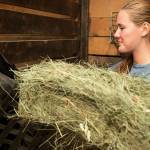Feeding Horses: When Not to Feed That Hay

As summer winds down in some parts of the world, many horse owners launch into hay-buying mode, some joyfully reconnecting with tried-and-true dealers and others frantically placing orders with hay growers new to them.
Choosing the right hay has much to do with the horse it is intended for—age, workload, energy requirements, and metabolic status, among other points. All horse owners run into red flags when doling out hay, leaving them to ask, “What is that in my hay?”or “Should I feed this to my horse?”
Here are three hay-feeding situations that call for closer inspection of the forage and a decisive plan of action.
Dust or mold. Dusty or moldy hay should not be fed to horses. Chronic inhalation of dust and mold increases mucus production and weakens air passages in the lungs, causing them to narrow and spasm. These changes describe the disease known as recurrent airway obstruction or heaves, which is part of the “equine asthma” umbrella of diseases. Horses diagnosed with heaves typically do not breathe normally during exercise, thus limiting their performance. Some horses with advanced disease breathe abnormally at rest and may not be able to exercise at all.
Aside from its effects on the respiratory system, mold can adversely affect the gastrointestinal tract, causing colic. Horses generally will not ingest moldy feedstuffs if a higher quality alternative is available. Horses cannot tolerate the gastrointestinal tract insult inflicted by certain molds or the toxins they produce because, like humans, they have a simple, single-chamber stomach. Cattle, on the other hand, are ruminants and possess a multichambered stomach more capable of handling molds.
Unusual plants. One feature of high-quality hay is purity. Hay made from a single forage species, such as timothy or alfalfa, would be considered pure hay, as would hay made from the intentional mixing of forage species (a grass-legume mixture). Hayfields are not impervious to weeds, so it is normal for horse owners to find occasional weeds in good-quality hay. Weeds should never overwhelm a bale of hay, though, as excessive weeds are often a hallmark of poor hayfield management. Though many weeds found in hayfields are harmless, others are poisonous or possess structures that can injure the soft tissues of the mouth. Finally, as forage analysis becomes more popular among horse owners, uniform hay—meaning one bale of hay is nearly identical to every other bale of hay in a load—allows for more accurate ration balancing.
Dead rodents and reptiles. Hayfields are a natural habitat for rodents and reptiles, so they are sometimes accidentally baled with hay during harvest. Decomposing carcasses incubate the spores of the bacterium Clostridium botulinum, and these spores can spill out into the surrounding hay. Ingestion of spores may cause botulism in horses. Though botulism is often linked to the feeding of round bales, carcasses are just as frequently found in square bales. If a dead animal is found in a hay bale, discard the entire bale. Consult with a veterinarian about the USDA-approved vaccine that prevents botulism.
Hay producers often do the best they can to eliminate weeds and other foreign material from their product. They know that clean hay is the best hay for horses. Once you find a reputable hay producer or dealer, work with him when you encounter a problem with your forage. He will likely be just as interested to hear your concerns as you are to impart them.








